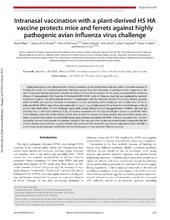| dc.contributor.author | Major, Diane | en_US |
| dc.contributor.author | Chichester, Jessica A. | en_US |
| dc.contributor.author | Pathirana, Rishi | en_US |
| dc.contributor.author | Guilfoyle, Kate | en_US |
| dc.contributor.author | Shoji, Yoko | en_US |
| dc.contributor.author | Guzman, Carlos A. | en_US |
| dc.contributor.author | Yusibov, Vidadi | en_US |
| dc.contributor.author | Cox, Rebecca Jane | en_US |
| dc.date.accessioned | 2015-12-31T10:24:59Z | |
| dc.date.available | 2015-12-31T10:24:59Z | |
| dc.date.issued | 2015-05 | |
| dc.Published | Human Vaccines & Immunotherapeutics 2015, 11(5):1235-1243 | eng |
| dc.identifier.issn | 2164-554X | |
| dc.identifier.uri | https://hdl.handle.net/1956/10846 | |
| dc.description.abstract | Highly pathogenic avian influenza H5N1 infection remains a public health threat and vaccination is the best measure of limiting the impact of a potential pandemic. Mucosal vaccines have the advantage of eliciting immune responses at the site of viral entry, thereby preventing infection as well as further viral transmission. In this study, we assessed the protective efficacy of hemagglutinin (HA) from the A/Indonesia/05/05 (H5N1) strain of influenza virus that was produced by transient expression in plants. The plant-derived vaccine, in combination with the mucosal adjuvant (3′,5′)-cyclic dimeric guanylic acid (c-di-GMP) was used for intranasal immunization of mice and ferrets, before challenge with a lethal dose of the A/Indonesia/05/05 (H5N1) virus. Mice vaccinated with 15 μg or 5 μg of adjuvanted HA survived the viral challenge, while all control mice died within 10 d of challenge. Vaccinated animals elicited serum hemagglutination inhibition, IgG and IgA antibody titers. In the ferret challenge study, all animals vaccinated with the adjuvanted plant vaccine survived the lethal viral challenge, while 50% of the control animals died. In both the mouse and ferret models, the vaccinated animals were better protected from weight loss and body temperature changes associated with H5N1 infection compared with the non-vaccinated controls. Furthermore, the systemic spread of the virus was lower in the vaccinated animals compared with the controls. Results presented here suggest that the plant-produced HA-based influenza vaccine adjuvanted with c-di-GMP is a promising vaccine/adjuvant combination for the development of new mucosal influenza vaccines. | en_US |
| dc.language.iso | eng | eng |
| dc.publisher | Taylor & Francis | eng |
| dc.rights | Attribution CC BY-NC | eng |
| dc.rights.uri | http://creativecommons.org/licenses/by-nc/3.0/ | eng |
| dc.subject | adjuvant | eng |
| dc.subject | c-di-GMP | eng |
| dc.subject | influenza H5N1 | eng |
| dc.subject | intranasal vaccination | eng |
| dc.subject | ferret infection model | eng |
| dc.subject | mice | eng |
| dc.subject | plant vaccine | eng |
| dc.subject | c-di-GMP | eng |
| dc.subject | (3′, 5′)-cyclic dimeric guanylic acid | eng |
| dc.title | Intranasal vaccination with a plant-derived H5 HA vaccine protects mice and ferrets against highly pathogenic avian influenza virus challenge | en_US |
| dc.type | Peer reviewed | |
| dc.type | Journal article | |
| dc.date.updated | 2015-12-21T20:15:36Z | |
| dc.description.version | publishedVersion | en_US |
| dc.rights.holder | Copyright 2015 The Authors | |
| dc.identifier.doi | https://doi.org/10.4161/21645515.2014.988554 | |
| dc.identifier.cristin | 1283757 | |
| dc.relation.project | Norges forskningsråd: 220670 | |

